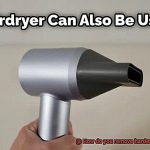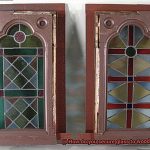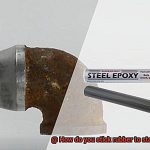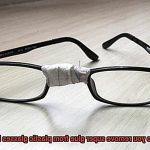Ever been stuck with the infuriating task of removing strong glue from your walls? You know the feeling – you try to spruce up your space, only to be left with stubborn residue that seems impossible to get rid of. But fear not. In this captivating blog post, we’re about to spill the beans on how to banish that sticky mess and restore your walls to their former glory.
Imagine this: you’ve spent hours painstakingly perfecting your room, only to be greeted by those pesky glue marks mocking your efforts. It’s enough to dampen anyone’s spirits. But don’t throw in the towel just yet; we’ve got your back.
Our quest for the ultimate solution starts by diving deep into the different types of adhesive that can wreak havoc on our walls. From superglue to construction adhesives, we’ll uncover the culprits behind your sticky situation.
Prepare yourself for a mind-blowing guide on removing these stubborn substances. We’ll introduce you to everyday household items that have magical powers when combined in just the right way. From vinegar’s versatility to heat’s efficiency, we’ll explore simple yet effective methods that will liberate your walls from their unwanted clingy companions.
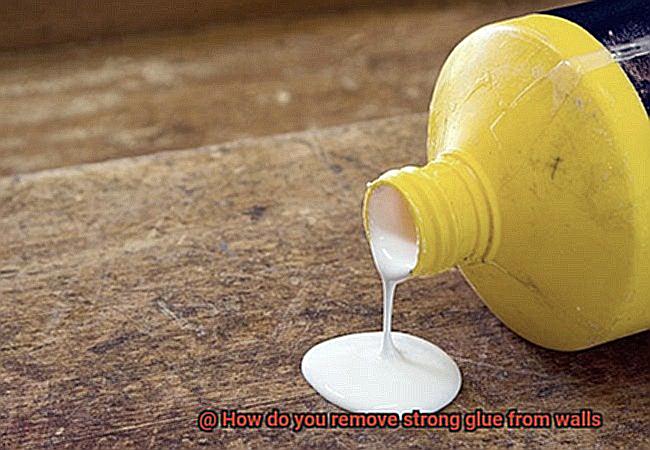
But wait, there’s more. We’ll also shed light on why it’s crucial to take precautions before diving into the glue removal process. Because let’s face it – prevention is always better than cure. Arm yourself with wisdom and protect your walls from future adhesive mishaps.
Get ready to bid farewell to all those glue-related woes as we unlock the secrets of restoring your walls’ pristine condition. Stay tuned for our step-by-step guide, where we spill insider tips and tricks that will make removing glue a breeze.
So if you’re tired of staring at unsightly marks and desperate to reclaim the beauty of your walls, buckle up and join us on this fascinating journey of unraveling the mysteries behind removing strong glue from walls.
What is Strong Glue?
Contents
Prepare to dive into the captivating world of strong glue, an adhesive marvel that revolutionizes industries and everyday applications. This article will illuminate the various types of strong glue available and equip you with effective methods for removing it from walls. Brace yourself for an adventure through the depths of bonding prowess.
Types of Strong Glue:
- Epoxy Adhesives: Experience the pinnacle of strength and chemical resistance with epoxy adhesives. Composed of two parts – the resin and the hardener – these glues create an unyielding bond through a captivating chemical reaction. Ideal for projects demanding unwavering durability.
- Super Glues (Cyanoacrylates): Witness the lightning-fast magic of super glues as they form instantaneous bonds upon encountering moisture. Versatile in their ability to bond various materials, these glues excel in quick fixes and securing small items. Beware, they may not withstand extreme temperatures or maintain flexibility.
- Polyurethane Adhesives: Enter the realm of versatility and exceptional bonding strength with polyurethane adhesives. They conquer both porous and non-porous surfaces with ease, while exhibiting remarkable resistance to water and heat. Although patience is required for curing, the reward is an unbreakable bond.
- Contact Adhesives: Marvel at the unrivaled mastery of contact adhesives in bonding large surface areas. Applying them to both surfaces before drying creates a flexible yet robust connection capable of enduring stress and movement. Witness the artistry of cohesive strength.
Removing Strong Glue from Walls:
- Heat and Scrape: Ignite your journey by softening the glue through the gentle embrace of heat from a gun or hairdryer. With precision, wield a plastic scraper or putty knife to delicately scrape away the softened adhesive, ensuring no collateral damage to the wall’s surface.
- Solvents or Adhesive Removers: Embark on a tantalizing quest with acetone, isopropyl alcohol, or commercial adhesive removers. Apply these potent solvents to a cloth or sponge, then gently rub them onto the glue until it surrenders to dissolution. Remember to test the solvent on a small area first to protect the paint or finish from harm.
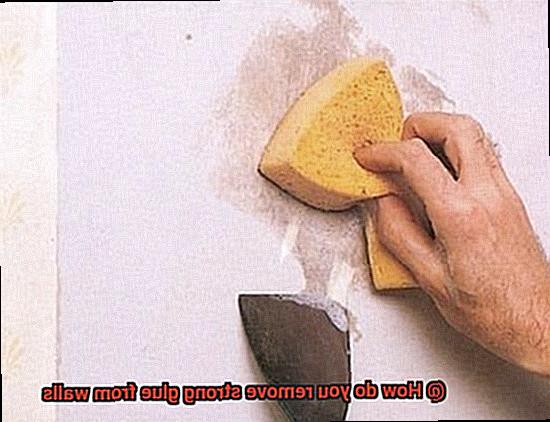
Types of Strong Glue

Well, it’s no surprise because there are various types of strong glue out there with their own set of unique properties. In this blog post, we will delve into the mighty power of strong glue and explore the different types commonly used on walls. Additionally, we will uncover effective techniques to safely remove them without leaving a mark. Let’s dive into this adhesive adventure.
Epoxy Glue: The Indestructible Bond
In the realm of strong glue, epoxy reigns supreme with its exceptional bonding strength and durability. This superhero adhesive consists of two components that must be mixed before application. Once it dries, it forms an indestructible chemical bond with the surface, making removal a daunting task without causing damage. Epoxy glue is often utilized for heavy-duty projects like mending broken metal or glass objects that require unmatched strength.
Construction Adhesive: The Foundation of Strength
When it comes to building and construction, construction adhesive is the ultimate go-to glue. This powerhouse adhesive is specifically engineered for heavy-duty applications such as installing drywall or paneling. It establishes a robust and permanent bond that can withstand any challenge thrown its way. However, one must exercise caution during application as construction adhesive sets quickly, making removal a challenging endeavor once it adheres to the wall.
Superglue: The Magic Touch
Superglue, also known as cyanoacrylate adhesive, possesses an enchanting ability to create an instant bond like magic. This fast-acting adhesive springs into action the moment it encounters moisture in the air. Perfect for quick fixes and minor repairs around the house, superglue forms an incredibly tight grip on surfaces like plastic, rubber, metal, and ceramics. Removing superglue from walls can prove to be a perplexing task due to its tenacious hold.
Liquid Nails: The Versatile Champion
Liquid Nails, a renowned brand of construction adhesive, offers an array of products tailored for different applications. This versatile adhesive is commonly employed in construction projects that demand a steadfast and permanent bond. With variations like heavy-duty, fast-drying, and waterproof formulas, Liquid Nails caters to various needs. However, removing this adhesive from walls can be challenging due to its potent adhesive properties.
Contact Cement: The Instant Fusion
Contact cement is a formidable force in the world of strong glue, capable of creating an instantaneous bond when two coated surfaces are pressed together. It finds frequent use in bonding materials such as laminates, veneers, and plastics. Available in water-based and solvent-based formulations, contact cement requires careful techniques during removal to prevent surface damage.
Heat and Scrape Method
Picture this: you’re faced with a wall covered in glue that seems to have taken on a life of its own. But fear not. Today, we’re about to embark on an adventure into the captivating realm of the Heat and Scrape Method. This technique is not only popular but also downright magical when it comes to bidding farewell to strong glue on walls. So, gear up with gloves and goggles, and let’s dive into the transformative power of heat.
Safety First:
Before we delve into the exciting world of glue removal, let’s prioritize safety. Shield yourself from burns and injuries by slipping into protective gloves and goggles. Oh, and don’t forget to banish any flammable objects from your workspace – we want sparks of excitement, not literal sparks.
Applying the Heat:
Now that we’re all suited up, it’s time to unleash the heat. Grab hold of your trusty heat gun or hairdryer and crank up the temperature to its highest setting. Position the device about 6-8 inches away from the stubbornly glued area, and commence a rhythmic back-and-forth motion. Can you feel the anticipation building? That’s the glue succumbing to the mesmerizing warmth.
Scraping Off the Glue:
As the glue surrenders its grip, it’s time to wield your scraper or putty knife like a hero on a mission. Begin at one edge of the affected area and gradually make your way towards the center, applying gentle yet firm pressure. Remember, we seek liberation for our walls, not destruction. If preservation is your priority, opt for a plastic scraper – a guardian angel for your precious surfaces.
Persistent Glue? No Match for Your Determination.
Occasionally, even glue can be stubborn beyond belief. But worry not. In these moments, perseverance shines brightest. Simply reapply heat to the unyielding adhesive and repeat the scraping process. Remember, patience is the virtue that will guide us through this journey. And if you crave an extra layer of protection, embrace the plastic scraper with open arms. Victory awaits.
Solvents or Adhesive Removers
We’ve all experienced the frustration of stubborn glue residue on our walls, but fear not. In this enchanting guide, we’ll unveil the mesmerizing world of solvents and adhesive removers. Get ready to bid farewell to sticky situations as we explore the most effective ways to conquer that clingy glue. So don your gloves and goggles, and let’s embark on this thrilling journey.
Acetone – The Mighty Dissolver:
Enter acetone, the superhero of adhesive removal. This potent solvent, commonly found in nail polish removers, boasts the power to dissolve various adhesives. However, beware its strength, for it can also harm certain surfaces. Exercise caution by conducting a small test on an inconspicuous area before unleashing its power.
Isopropyl Alcohol – Rubbing Away Sticky Woes:
Isopropyl alcohol, also known as rubbing alcohol, emerges as a gentler alternative to acetone. With its ability to dissolve and remove glue without causing significant damage, it proves a reliable ally in your quest for a pristine wall. As always, embark on your adventure by testing it on a small area beforehand.
Goo Gone – The Enchanting Elixir:
Behold, the commercial magician known as Goo Gone. This remarkable adhesive remover is specifically crafted to combat sticky substances like glue, stickers, and tape residue. Its enchanting formula ensures safety on most surfaces. Simply apply it directly to the glue, let it work its magic for a few minutes, and watch as the residue disappears with a swift wipe of a cloth or sponge.
WD-40 – Beyond Lubrication:
Prepare to have your mind blown. WD-40, renowned for its lubricating prowess, reveals its hidden talent as an adhesive remover. Spray a small amount onto the glue, let it work its alchemical wonders for a few minutes, and then witness as the residue surrenders to your cloth or sponge.

Soaking and Scrubbing Method
Fear not, for the soaking and scrubbing method is here to save the day. With a touch of magic, a splash of water, and some gentle scrubbing, those stubborn adhesive remnants will vanish before your eyes. So, gather your supplies, protect your surroundings, and let’s embark on this enchanting journey.
Materials Needed:
To unlock the power of this method, assemble your arsenal. Warm water, mild dish soap, a sponge or soft cloth, and a trusty plastic scraper (or even an old credit card) will be your faithful companions in this quest for adhesive freedom.
Preparation:
Before we unleash our magical powers, let’s ensure we’re fully prepared. Shield the surrounding surfaces by draping them with plastic or drop cloths. And remember, fresh air is our ally, so allow good ventilation in the room to keep any fumes at bay. Safety is key in this magical adventure.
Testing on a Small Area:
Each wall surface holds its own secrets, so let’s unravel them cautiously. Begin by testing the adhesive remover on a small, inconspicuous spot. This charm will reveal any potential damage or discoloration, allowing us to avoid any unexpected sorcery.
Soaking:
Now it’s time to immerse ourselves in the first phase of our spellbinding ritual. Imbue your sponge or cloth with warm water, ensuring to wring out any excess liquid. Then, infuse it with a small amount of mild dish soap. With gentle strokes, spread this enchanted solution onto the glue-covered area and let it work its magic for a few moments.
Scrubbing:
Patience and persistence are the keys to unlocking success in our mystical endeavor. Once the solution has permeated the glue’s defenses, arm yourself with the sponge or a soft-bristle brush. In circular motions, channel your magic and delicately scrub away at the adhesive. Remember, we aim to vanquish the glue, not harm the wall, so proceed gently yet persistently.
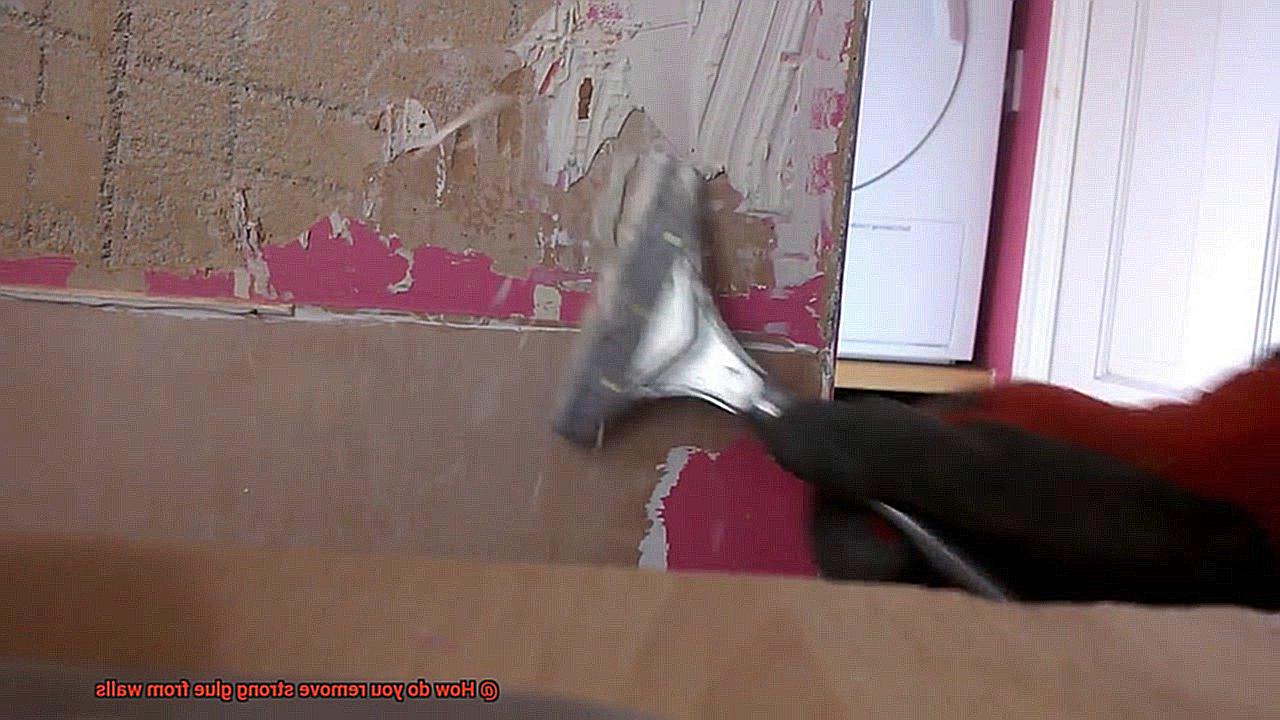
Natural Remedies for Removal
Fear not. I am here to present you with a captivating array of natural remedies that will breathe new life into your walls. Beyond their effectiveness, these remedies are eco-friendly and non-toxic. Prepare yourself for a magical journey of wall restoration.
Vinegar: The Acidic Marvel
Vinegar, with its acidic properties, is a true hero in breaking down adhesive glue. Immerse a cloth or sponge in vinegar and apply it directly to the glue. Grant it a few moments to work its wonders, then gently scrub the area using a soft brush or cloth. Rinse with water, and if needed, repeat the process. Witness the enchantment as your walls regain their former glory.
Baking Soda and Coconut Oil: The Dynamic Duo
Unleash the power of this dynamic duo by combining equal parts baking soda and coconut oil to form a potent paste. Apply this concoction to the glue and let it rest for a few minutes. Then, summon your inner sorcerer as you softly brush or rub the area until the glue begins to loosen its grip. Rinse with water, and behold the transformation of your walls.
Lemon Juice: The Zesty Spell
Lemon juice, known for its zesty aroma, holds remarkable adhesive-breaking powers. Squeeze fresh lemon juice onto the affected area and allow it to permeate for a few minutes. Embrace your gentle touch as you employ a soft brush or cloth to scrub away the stubborn glue. Finish with a refreshing rinse of water, leaving behind walls that exude a citrusy freshness.
Warm Water: The Soothing Elixir
Sometimes, all it takes is a touch of warmth to soften even the most resilient glue. Immerse a cloth or sponge in warm water and apply it to the adhesive. Allow the soothing elixir to work its magic for a few minutes before gently scrubbing the area using circular motions. Witness the dissolving of the glue, leaving your walls feeling revitalized. Rinse with water, and bask in the gratitude of your walls.
Sanding or Buffing Method
We have just the enchanting remedy to liberate your walls from that adhesive prison. Join us on a journey through the captivating world of the sanding or buffing method, a tried-and-tested technique that will restore your walls to their former glory. So grab your sandpaper and prepare to witness the mesmerizing transformation of your walls.
Preparing for the Magic:
Before diving into this magical process, it’s vital to prepare the stage properly. Shield nearby furniture and objects with plastic sheets or drop cloths to protect them from the impending dance of dust and debris. With this precaution in place, you can focus solely on the spellbinding restoration of your walls.
The Enchanted Tools:
To embark on this mystical adventure, gather your trusted sanding block or electric sander, alongside fine-grit sandpaper. Choosing the perfect grit size is key, considering both the wall surface type and the strength of the glue residue. Start with a lower grit size and gradually ascend if necessary, ensuring a harmonious blend of efficiency and precision.
The Dance of Sanding:
Now, let us begin our enchanting dance with the sandpaper. With graceful circular motions and gentle pressure, lightly caress the glue residue. Be mindful not to impose too much force upon your walls, as they are delicate creatures. Continue this rhythmic sanding until you witness the magical disappearance of the glue residue.
Banishing Stubborn Residue:
In rare cases where stubbornness persists, an extra touch of sorcery may be required. Enter the mystical buffing pad or polishing compound. Anoint the pad with a small amount of compound and delicately massage it in circular motions over the troubled area. Watch closely as this act breaks down the glue, transforming it into a distant memory.
The Final Flourish:
With the glue residue banished, it’s time to add the final touch of magic. Gently cleanse your walls with warm soapy water and a sponge, ensuring that any lingering dust or residue from the sanding process is vanquished. Rinse your walls thoroughly, allowing them to dry in their newfound purity before you proceed with painting or wallpapering.
Tips for Successful Glue Removal
Fear not. In this comprehensive guide, we will provide expert tips and tricks to help you successfully eliminate those stubborn adhesive residues. Whether you’re dealing with epoxy, construction adhesive, or super glue, our methods will empower you to conquer any sticky situation. So, let’s dive in and bid farewell to unwanted glue stains.
Identify the Glue Type:
Embark on your glue removal journey by first identifying the type of adhesive you’re dealing with. Understanding the specific glue will allow you to tailor your removal approach accordingly. Common strong glues include epoxy, construction adhesive, and super glue. Armed with this knowledge, you can confidently proceed to the next step.
Protect the Surrounding Area:
Before commencing any removal method, take precautionary measures to safeguard the surrounding area. Shield adjacent surfaces by covering them with plastic or newspaper. This simple act of protection will prevent accidental damage or unsightly stains, ensuring a successful glue removal process.
Gentle Scraping:
Equip yourself with a plastic scraper or putty knife and delicately scrape off as much dried glue as possible. Exercise caution to avoid scratching or damaging the wall surface during this process. Remember, patience is key as you work diligently to remove every last trace of adhesive.
Heat and Soften:
If scraping alone proves insufficient, it’s time to employ the power of heat to soften that stubborn glue. By directing a heat gun or hairdryer at the adhesive, it becomes more malleable and easier to remove. However, exercise caution as excessive heat can potentially harm the wall surface. Begin by testing this method in a small area before proceeding further.
Solvents and Adhesive Removers:
For those insistent glues that refuse to budge, solvents and adhesive removers are your trusty allies. Consider using acetone, isopropyl alcohol, or commercial adhesive removers for optimum results. Apply the chosen solvent or remover to a cloth or sponge and gently rub it onto the glue until it starts dissolving. Always conduct a test on a discreet area to ensure compatibility with the wall surface.
Persistence Pays Off:
Removing stubborn glues may require repeated attempts, but don’t be disheartened. Persevere until every last trace of glue is eradicated. Patience, persistence, and unwavering determination will ultimately lead to successful removal.
Conclusion
Removing strong glue from walls can be a daunting task, but fear not.
There are several effective methods you can try. One option is to use heat.
Grab a hairdryer and aim it at the glue, applying heat until it softens. Then, gently scrape off the glue with a plastic scraper or credit card.
Another approach is to use rubbing alcohol or nail polish remover. Soak a cloth in either of these solutions and dab it onto the glue, allowing it to sit for a few minutes before wiping away.
For tougher glue stains, you may need to use a commercial adhesive remover. Apply it according to the manufacturer’s instructions, using caution and ensuring proper ventilation.
Remember to test any method on a small inconspicuous area first to avoid damaging your walls.


